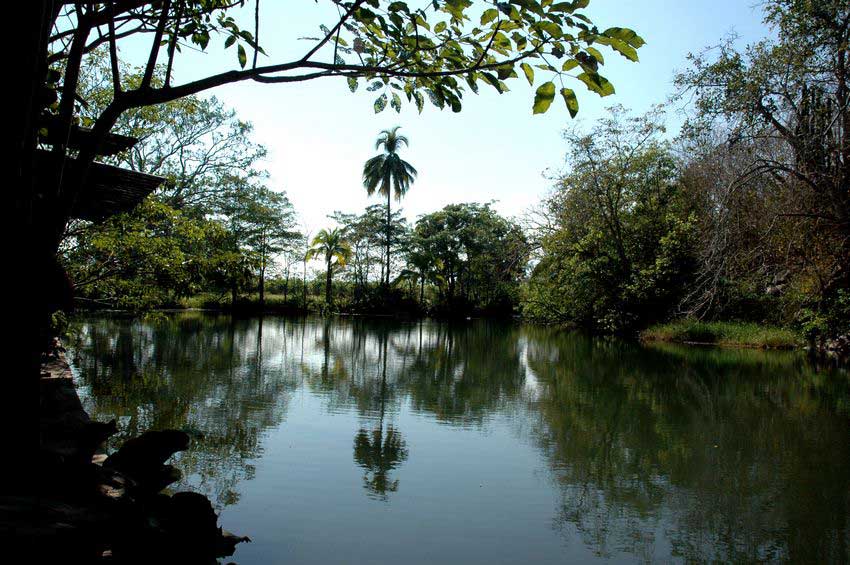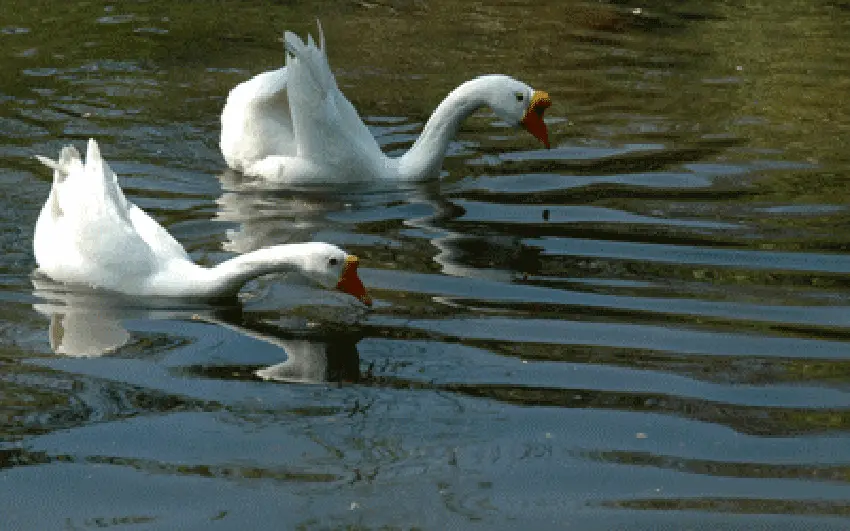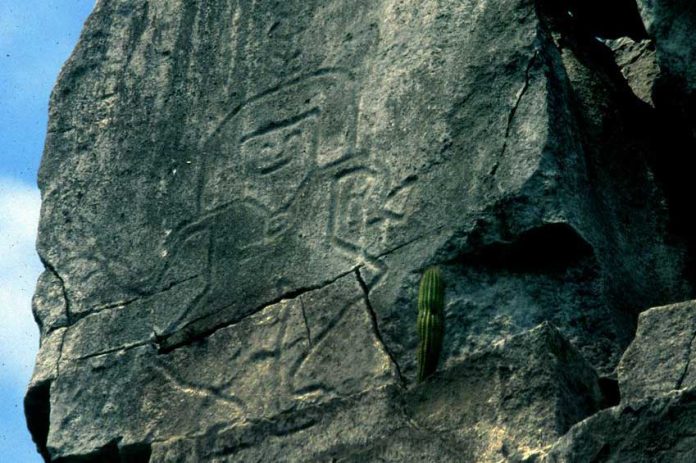Many years ago I heard rumors that there was a large and curious cave somewhere near the little town of Casimiro Castillo, about 50 kilometers inland from the Pacific port of Barra de Navidad.
“Inside that cave is a spiral staircase that takes you down to an underground river,” we had been assured, but reaching the place from Guadalajara would require us to drive all day along narrow, winding, Highway 80.
Still, we felt it would be worth it and indeed, the moment we reached Casimiro Castillo and turned off the highway, we immediately stumbled upon something extraordinary.
A dirt road led us to the foot of a sheer wall of pure marble. Even from afar, we could see that the wall was covered with petroglyphs. There were the usual spirals, of course, but there were also many recognizable depictions of dogs, frogs, arrows and suns and, most remarkable of all, there was a human figure at least a meter tall, dressed most curiously in baggy pants and wearing something resembling a helmet topped with something resembling a feather.
These engravings, an archaeologist suggested, were probably made between 700 and 1020 AD and were used as a kind of bulletin board where something new was added every year for some important festival: 500 years of breaking news, still there for all of us to see.

This hill, we soon discovered, was only one of seven marble mountains in the area. Since marble is a kind of limestone, we were convinced it would only be a matter of time before we located the Cave of the Winding Staircase.
This conviction was strengthened when local people told us that they did indeed know of a big cave in the area. We followed their instructions and came to a small lake fed by a warm spring, a perfect place for camping. They called this La Laguna del Altilte and just above it we found the entrance to the cave they had told us about.
We ducked through a low but wide opening and gingerly walked down a slope into a truly amazing cavern. While the outside surface of the marble hill was weathered and grey, here, inside the cave, we could see its true colors on the smooth, wet, undulating walls. Just watching water drip from a multicolored stalactite was a pleasure.
Although we found no sign of a circular staircase in this cave, we did discover a big balcony with an upper passage leading who knew where.
Exploring this upper level proved no easy task. The balcony was filled with a black soup of bat guano mixed with water, and squirming in this goo were countless millipedes about 10 centimeters long: totally harmless to humans, of course, but not the greatest bedfellows for those of us who had to crawl on hands and knees through a long, low, narrow passage connecting the balcony to the Steam Room, a big chamber whose extreme heat and humidity wreaked havoc with our cameras.
On top of that, the chamber was filled with great, flat slabs of rock, all of them liberally coated with gooey guano. Any attempt to cross one of these slabs would send the caver sliding down in the darkness on his or her bottom towards who knows what. It is surprising we managed to get out of there without breaking a leg and we never carried on to see whether the mythical spiral staircase lay somewhere ahead.

Covered with guano from head to toe, we would exit the cave with no other desire than to jump straight into the warm waters of the lagoon.
As we explored the area, we found more caves in almost all of those marble mountains, and a delightful, rustic thermal spring called Balneario Agua Caliente with pools at different temperatures that empty into an enchanting lagoon populated with ducks and geese and surrounded by tall palm trees, with cows grazing in an adjacent pasture.
This little paradise is located in a hilly area 17 kilometers southwest of Casimiro Castillo and is one of very few balnearios (water parks) we have ever found where you can swim or camp with no problems from radios or noisy crowds.
This is just one of many hot springs we found among those hills of marble, making it easy to see why pre-Hispanic people would have chosen this area for their annual shindig.
The petroglyphs of Casimiro Castillo are a perfect example of the hidden attractions within what I call the Magic Circle of western Mexico. They are, as well, a typical example of how vulnerable are these unprotected gems.
We returned to El Altilte Lagoon again and again to camp on its shore while we worked on mapping the cave and studying its bat population. One day, however, we arrived at the campsite only to discover that the lake had disappeared entirely, now replaced by crops and meadows. “What happened to the laguna?” we asked a local rancher.

“Some entrepreneurs came along and decided to pump it dry,” he told us.
Sad to say, a similar fate has befallen some of the petroglyphs on the ancient bulletin board. One day we discovered that several of them were missing. Someone had made off with a chunk of the wall, perhaps weighing tonnes. No doubt this precious relic of Mexico’s history now graces someone’s cantina or front yard.
I could list many more sites of natural beauty or archaeological importance in rural western Mexico that are protected neither by fences nor by guards. Rather than waiting for local or national government officials to take care of them, perhaps some organization that appreciates such places could investigate practical ways to preserve these little-known treasures before they vanish.
The easiest way to visit the attractions hidden among these marble mountains is to ask your GPS to take you to Casimiro Castillo, La Resolana, Jalisco, or the nearby town of La Concepción and then to ask a local person to show you around.
[soliloquy id="70287"]
The writer has lived near Guadalajara, Jalisco, for more than 30 years and is the author of A Guide to West Mexico’s Guachimontones and Surrounding Area and co-author of Outdoors in Western Mexico. More of his writing can be found on his website.
